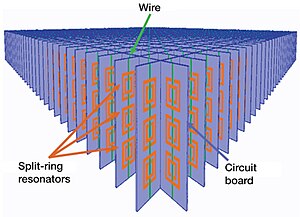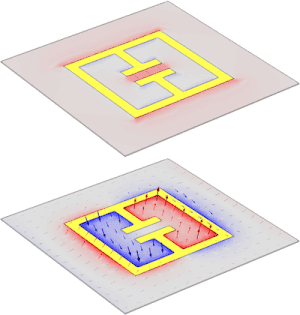

A split-ring resonator (SRR) is an artificially produced structure common to metamaterials. Its purpose is to produce the desired magnetic susceptibility (magnetic response) in various types of metamaterials up to 200 terahertz.
- ^ Smith, D. R.; Padilla, WJ; Vier, DC; Nemat-Nasser, SC; Schultz, S (2000). "Composite Medium with Simultaneously Negative Permeability and Permittivity". Physical Review Letters. 84 (18): 4184–7. Bibcode:2000PhRvL..84.4184S. doi:10.1103/PhysRevLett.84.4184. PMID 10990641.
- ^ Shelby, R. A.; Smith, D. R.; Nemat-Nasser, S. C.; Schultz, S. (2001). "Microwave transmission through a two-dimensional, isotropic, left-handed metamaterial". Applied Physics Letters. 78 (4): 489. Bibcode:2001ApPhL..78..489S. doi:10.1063/1.1343489.
- ^ Degl’Innocenti, R. (2014). "Low-Bias Terahertz Amplitude Modulator Based on Split-Ring Resonators and Graphene". ACS Nano. 8 (3): 2548–2554. doi:10.1021/nn406136c. PMID 24558983.
